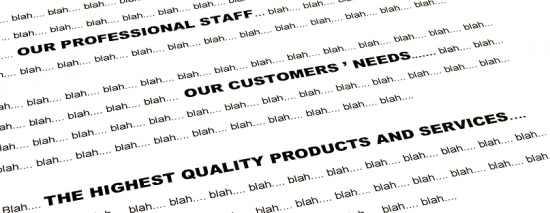There is a tacit assumption that SEO friendly copy will detract from the user experience. This is not true. This is only true in the following cases:
- Keywords are inserted after the copy was written.
- The copy is written by an unskilled writer.
- The copy is unnecessarily keyword stuffed.
In the right hands, SEO friendly copy doesn’t have to sound unnatural. If written by someone with a good understanding of how to optimise content for SEO but who is also a skilled writer then there is no reason why the content needs to be any less user-friendly than it is search friendly.
Consider this: keyword density is important for letting search-bots know what the content is about so they can assess how relevant it is for a particular search. But users will also make very quick decisions about whether they’ve arrived at the right place, and seeing the words that they searched for (or related terms) dotted all over the page will do nothing but confirm their click.
Of course, some keywords are easier to incorporate into content than others, but one thing’s for certain: it’s much easier to base content around keywords than it is to shoehorn keywords into content. It is for this reason that SEO should be considered right from the beginning stages of web development. It may very well influence page titles (not just title tags) and the nature of content, as well as the content itself.
By considering SEO right from the start, you stand the highest chance of making natural sounding SEO friendly content rather than crow-barring in awkward phrases purely for the benefit of search engines. If this is what you find yourself doing, you have to ask yourself: is it worth getting high search results if everyone who ends up on your site is put off my awkward copy?
SEO friendly content is a compromise, of course it is. But by setting out with that compromise in mind, a happy medium is much more likely to be achieved than making it afterwards. Your copy needs to satisfy search-bots and users alike.
With all of the above in mind, here are the basics of making SEO friendly copy.
Title

The title of the content has a tremendous bearing on what Google thinks your page is about. This holds for the on-page title, the title tag and the URL. Making sure it includes your keyword is of utmost importance, and this will help you to reuse the keyword in the rest of the content. Remember how at school you would always restate the question in the answer?
Again, this doesn’t have to make an awkward title that no one wants to read. Be careful to fit your keyword in to make a natural title that is as geared towards enticing the reader as it is to upping your search rankings.
Relevancy

As much about place as content, make sure that if you’re posting on third party sites you’re posting on related sites in related categories (if appropriate). Accepting that offer of an article hosted on that casino website linking back to your sustainable tires site is not going to help. The more relevant the site, the more you establish relevancy to your desired keyword.
Keyword Density

Having your keyword in the title but nowhere in the content isn’t going to do you any favours. You need to reinforce the keyword throughout the copy so that it comes up as the most relevant topic for your site. You know those tag clouds that show you the most used phrases? You want your keyword to be the big bold one. Keep keyword density in mind while you are writing so you don’t have to artificially introduce it later. Thinking about keywords whilst you write will fundamentally change your sentence structure, if not the content of your copy entirely.
Length

Your content needs to be long enough to stand a chance of being considered authoritative. Estimates vary on content length, but 400 words is a good minimum to aim for. It gives you enough space to provide content of genuine worth and keep in enough keyword instances to make for some genuine SEO benefit. Short copy can be too easily dismissed as spammy by both Google and readers, but too-long content will often put off users whose attention spans have been eroded by too much micro-blogging.
The best copy will provide as much user experience as SEO benefit and confer as much PR advantage as search. Keeping both in mind from the start will help to achieve that. Copywriters well versed in the principles of SEO are much more useful than separate copywriters and SEO experts.

These are great content writing tips. Thanks for taking the time to put this together.